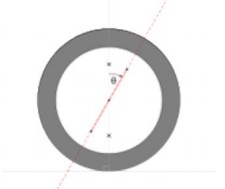Chapter: Mechanical : Automobile Engineering : Steering, Brakesa and Suspension Systems
Ackermann steering geometry
Ackermann steering geometry

Caster angle θ indicates kingpinpivot line and
gray area indicates vehicle's tire with the wheel
moving from right to left. A positive caster angle aids in directional
stability, as the wheel tends to trail, but a large angle makes steering more
difficult.
Curves described by the rear wheels of a conventional
automobile. While the vehicle moves with a constant speed its inner and outer
rear wheels do not.
The basic aim of steering is to ensure that the wheels are
pointing in the desired directions. This is typically achieved by a series of
linkages, rods, pivots and gears. One of the fundamental concepts is that of
caster angle – each wheel is steered with a pivot point
ahead of the wheel; this makes the steering tend to be self-centering towards
the direction of travel.
The steering linkages connecting the steering box and the
wheels usually conforms to a variation of Ackermann steering geometry, to
account for the fact that in a turn, the inner wheel is actually travelling a
path of smaller radius than the outer wheel, so that the degree of toe suitable
for driving in a straight path is not suitable for turns. The angle the wheels
make with the vertical plane also influences steering dynamics (see camber
angle) as do the tires.

Rack and pinion, recirculating ball, worm and sector
Rack and pinion steering
mechanism:
1.
Steering wheel;
2.
Steering column;
3.
Rack and pinion;
4.
Tie rod;
5.
Kingpin
Rack
and pinion unit mounted in the cockpit of an Ariel Atom sports car chassis. For
most
high volume production, this is
usually mounted on the other side of this panel
Steering
box of a motor vehicle, the traditional
(non-assisted), you may notice that the
system allows you to adjust the
braking and steering systems, you can also see the attachment
system to the frame.
Many modern cars use rack and pinion steering mechanisms,
where the steering wheel turns the pinion gear; the pinion moves the rack,
which is a linear gear that meshes with the pinion, converting circular motion
into linear motion along the transverse axis of the car (side to side motion).
This motion applies steering torque to the swivel pin ball joints that replaced
previously used kingpins of the stub axle of the steered wheels via tie rods
and a short lever arm called the steering arm.
The rack and pinion design has the advantages of a large
degree of feedback and direct steering "feel". A disadvantage is that
it is not adjustable, so that when it does wear and develop lash, the only cure
is replacement.
Older designs often use the recalculating ball mechanism,
which is still found on trucks and utility vehicles. This is a variation on the
older sector design; the steering column turns a large screw (the "worm
gear") which meshes with a sector of a gear, causing it to rotate about
its axis as the worm gear is turned; an arm attached to the axis of the sector
moves the Pitman arm, which is connected to the steering linkage and thus
steers the wheels. The recalculating ball version of this apparatus reduces the
considerable friction by placing large ball bearings between the teeth of the
worm and those of the screw; at either end of the apparatus the balls exit from
between the two pieces into a channel internal to the box which connects them
with the other end of the apparatus, thus they are "recalculated".
The recirculating ball mechanism has the advantage of a much
greater mechanical advantage, so that it was found on larger, heavier vehicles
while the rack and pinion was originally limited to smaller and lighter ones;
due to the almost universal adoption of power steering, however, this is no
longer an important advantage, leading to the increasing use of rack and pinion
on newer cars.
The recirculating ball design also has a perceptible lash, or
"dead spot" on center, where a minute turn of the steering wheel in
either direction does not move the steering apparatus; this is easily
adjustable via a screw on the end of the steering box to account for wear, but
it cannot be entirely eliminated because it will create excessive internal
forces at other positions and the mechanism will wear very rapidly. This design
is still in use in trucks and other large vehicles, where rapidity of steering
and direct feel are less important than robustness, maintainability, and
mechanical advantage.
The worm and sector was an older design, used for example in
Willys and Chrysler vehicles, and the Ford Falcon (1960s).
Other systems for steering exist, but are uncommon on road
vehicles. Children's toys and go-karts often use a very direct linkage in the
form of abellcrank (also commonly known as a Pitman arm) attached directly
between the steering column and the steering arms, and the use of
cable-operated steering linkages (e.g. the Capstan and Bowstring mechanism) is
also found on some home-built vehicles such as soapbox cars and recumbent
tricycles.
Related Topics